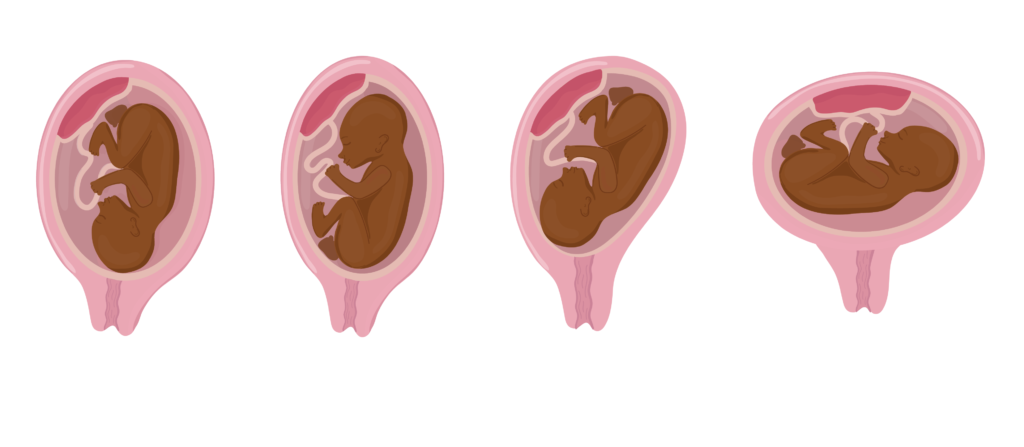“Your baby is presenting breech.”
It’s an expression many pregnant women fear they might hear as they go into labor.
But what does it mean?
According to the American Pregnancy Association, there are three different types of breech presentation: complete breech, frank breech, and incomplete breech.
1. A complete breech is when the baby’s buttocks are pointing downward, its legs are folded at the knees, and its feet are near the buttocks.
2. A frank breech is when the baby’s buttocks are pointed towards the birth canal while its legs are sticking straight up in front of its body and its feet are near the head.
3. Lastly, in an incomplete breech position, one or both feet point downward and will deliver before the rest of the body.
Why Does Breech Birth Happen?
Why does a baby present breech? Is there something wrong with the pregnant body?
According to the American Pregnancy Association, the causes of breech presentation are not fully understood, but breech birth is more common:
- With people who have been pregnant before
- In pregnancies carrying more than one baby
- When there is a history of premature delivery
- When a uterus has had too much or too little amniotic fluid
- When a uterus is abnormally shaped or has an abnormal growth
- In people who have placenta previa

Some pregnant people don’t fall into these criteria. So what else could cause the baby to stay upright?
In Gail Tully’s book “Spining Babies,” she writes that our lifestyle can create an imbalance that impedes the design of the womb. She posits that modern life can tighten, loosen or twist important structures in the body, such as muscles or ligaments, which determine the uterus and the baby’s position. This may lead to longer and harder labor, or an unfavorable position, such as the breech presentation.
According to the website Pregnancy, Birth and Baby, the chance that a baby will turn naturally when labor begins is about 1 in 8. But if this is not the person’s first pregnancy, the chance of the baby turning naturally is about 1 in 3.
Supporting Your Baby to Turn
While it is often unclear why the baby doesn’t turn head down, here are six techniques you can use to help your baby turn around.
- Chiropractic Care – The Webster Technique describes a specific chiropractic sacral analysis and diversified adjustment (ICPA).
- Acupuncture – Acupuncture involves inserting tiny metal needles into the skin to stimulate specific points in the body. Here, the practitioner attempts to balance the yin (cold, slow) and the yang (hot, excited) forces in the body to allow a flow of qi (life force) (Healthline Media, 2021).
- Spinning Babies – This technique uses specific stretches to help make room for baby by releasing pain or tension in the muscles around the pelvis and uterus (Gail N. Tully, 2018)
- Prenatal Yoga – Yoga is effective in reducing anxiety and depression in pregnant persons. Yoga offers modifiable exercises that can provide maternal and fetal benefits when practiced regularly during pregnancy.
- Prenatal Massages – This type of massage may relive some of the aches and pains of pregnancy.
- External Cephalic Version (ECV) – This technique is used to turn a breech baby to head first presentation using external cephalic version.
Please always remember to consult your medical and birthcare team which of the above might be most supportive and risk-free for you and your baby.
References
American Pregnancy Association (2021), Breech Births, retrieved from: https://americanpregnancy.org/healthy-pregnancy/labor-and-birth/breech-presentation/
American College of Obstetricians and Gynecologists (2021). If your Baby is Breech, Retrieved from https://www.acog.org/womens-health/faqs/if-your-baby-is-breech#:~:text=In%20the%20last%20weeks%20of,come%20out%20first%20during%20birth.
Babbar, S. & Shyken, J. (2016). Yoga in pregnancy. Clinical Obstetrics and Gynecology, 59(3), 600-613.
Breech Without Borders. Retrieved from https://www.breechwithoutborders.org/
Cluver, C. et al. (2015). Interventions for helping to turn term breech babies to head first presentation when using external cephalic version (review). Cochrane Database of Systematic Reviews, 2. DOI: 10.1002/14651858.CD000184.pub4.
Gail N. Tully (2018). Spinning Babies; Parent Class Companion eBook. Maternity Hous Publishing, Inc.
Healthline Media (2021). Is acupuncture safe while pregnant? https://www.healthline.com/health/pregnancy/acupuncture-during-pregnancy#takeaway
ICPA. About the Webster Technique. Retrieved from https://icpa4kids.com/training/webster-certification/webster-technique/?gclid=Cj0KCQjwtrSLBhCLARIsACh6Rmg2vuVKa8FpSM7duQ5ujKr1Zsaxupu1MBZtRYAIK09b5ku7fWESgOIaAriTEALw_wcB
Pregnancy, Birth and Baby. Breech Pregnancy. Retrieved from https://www.pregnancybirthbaby.org.au/breech-pregnancy
Sheffield, K. M. & Woods-Giscombé, C. L. (2016). Efficacy, feasibility, and acceptability of perinatal yoga on women’s mental health and well-being: A systematic literature review. Journal of Holistic Nursing, 34(1), 64-79.
VeryWell Family (2021). Benefits and risks of prenatal (pregnancy) massage. Retrieved from https://www.verywellfamily.com/pregnancy-massage-what-you-need-to-know-89742
Podcast:
EBB 111 – Positioning Breech Babies with Dr. Elliott Berlin
Image credits: Loreanto
